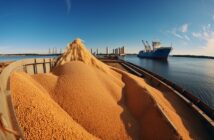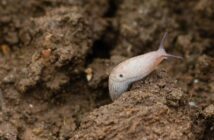For David Hoyles, farms director at GH Hoyles, Long Sutton in Lincolnshire, winter wheats are coming into the spring looking promising, despite a mix of planting dates as a consequence of the very wet weather.
However he is concerned that the recent prolonged spell of dry weather may impact further on the later drilled crops that have struggled with poor establishment.
Drilling started well, with winter wheat planted after vining peas around October 10, he points out. “However, the constant wet weather delayed lifting the sugar beet, so, as a result, the last of the wheat to be drilled went into cold, waterlogged soil in February.”
“Our soils are mainly Wisbech series alluvial Grade 1 silt, and the soil structure suffered with the continuous rain and may now become worse as conditions have now become very dry.”
“As a result the roots, which had little stimulus for growing when it was so wet, may now find it difficult to penetrate and scavenge for water and nutrients.”
“Whilst the crops are not looking too bad now, our results will be very dependent on what the weather does as we go on through spring and into summer, particularly with the late-drilled crops.”
“If they do not have a chance to develop their rooting system and we have a drought, it could be a perfect storm.”
If that happens, he is concerned that there may be up to a 15% hit on yields, which last year averaged 10.4 t/ha across the farm.
“However, it is early days yet and we do not know how the rest of the season will develop.”
But he is giving the late-drilled wheat its best chance, by protecting and nurturing it as much as possible.
Nutrition strategy and fertiliser applications are fine-tuned, and very much dependent on the previous crop and how much N is left in the soil, he points out. “Soil Mineral N (SMN) core samples are taken to estimate available nitrate and ammonium, after the winter rainfall and previous cropping.”
“As we grow a wide range of crops, we apply different strategies. For example, wheat following vining peas or kale typically receives 160 kg/ha N, whereas after sugar beet we find it needs 240 kg/ha.”
His herbicide strategy is also targeted according to the particular conditions and weed burden of each field. “Our main weeds are potato volunteers, small nettle, cleaver and some polygonums.”
“We use a pre-emergence spray at drilling, and then have a tidy up at T1; our usual spend on herbicide is around £50-£60 per hectare.”
“This year, we found some early signs of yellow rust in the backward wheat. It was not yet ready for T0, so we applied tebuconazole to get on top of it.”
Moving on to discuss variety choice, David says: “I am looking for a variety that performs on my soil type from looking at trials.”
“If it is high yielding and soft, then that helps due to potential price premiums. Other characteristics like maturity, orange wheat blossom midge (OWBM) resistance and lodging, play an important role in my decision making.”
Having previously grown LG Skyscraper very successfully as a seed crop, the choice had been clear for the well-established enterprise.
Weetabix, is an important market in the area and the variety is now on the company’s approved list.
“I like LG Skyscraper and it has performed well for us in the past, otherwise I wouldn’t have grown it again!”
LG Skyscraper performed well in the 2018 drought, averaging yields of 13.4 t/ha. Comparing it to other wheats on the farm in 2018, Graham yielded 13.4 t/ha, Frieston 12.19 t/ha and LG Jigsaw 13.15 t/ha.
LG Skyscraper also produced an acceptable yield in the saturated soils of 2019 of 11.6 t/ha. In 2019, Graham reached 10.63 t/ha, Graduate 10.54 t/ha and Frieston 9.96 t/ha – this was partly because a Frieston field was knocked by a hail storm just before harvest and lost a lot of yield, and also went flat, he explains.
When choosing a variety, David looks at Septoria and fusarium scores. “We can have quite big issues with them both, being our biggest potential yield robbers.”
He notes that as a tall variety, LG Skyscraper needs an application of a robust PGR. “We have found it to stand up fairly well to relative drought and flooding but two years ago, strong winds in July caused some problems in the seed crop.”
Looking at this year’s crop, the LG Skyscraper winter wheat planted after vining peas around October 10, reached Growth Stage (GS) 30 during the last week of March, and received its T0 and PGR.
“The autumn planted fields are showing potential for a relatively good crop this year, so fingers crossed we get through this dry period relatively unscathed,” says David.
| October planted wheat | February planted wheat | |
| Soil type | Wisbech series alluvial Grade 1 silt | Wisbech series alluvial Grade 1 silt |
| Soil condition | Moist and warm | Wet and cold |
| Tillage/drilling strategy | Patriot, combi drill | Subsoil, plough, combi drill |
| Previous crop | Vining peas | Sugar beet |
| Seed rate | 250 to 280 per sq. m | Up to 400 per sq. m |
| Nitrogen | 160 kg/ha | 240 kg/ha |
| T0 and PGR | Applied last week of March | Applied second week of April |
| Extra care | Application of tebuconazole for yellow rust |




